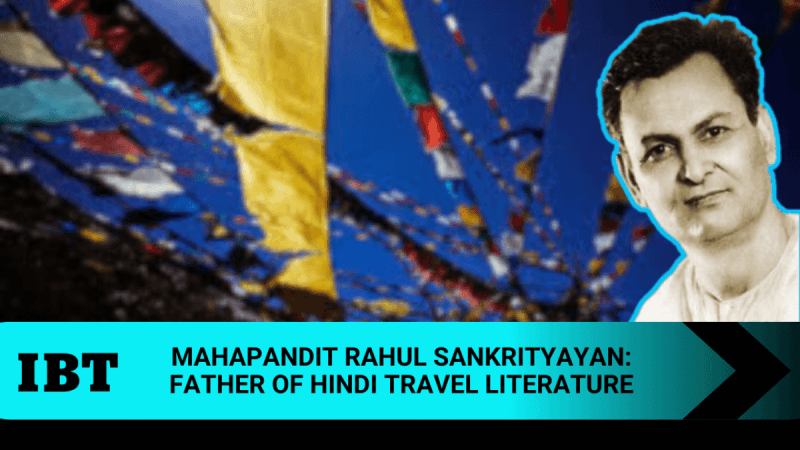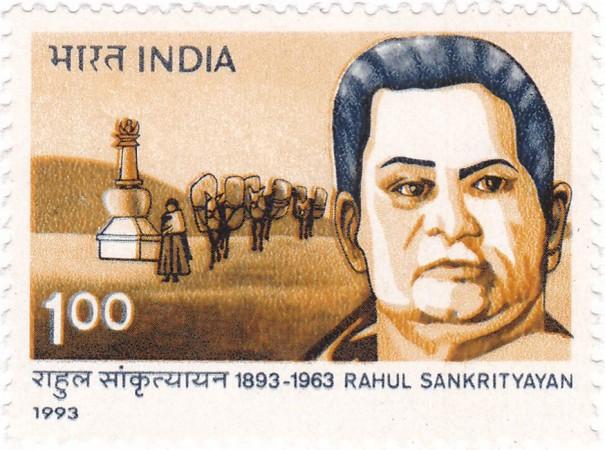
April 9 happens to be the 131st birth anniversary of one of the greatest travellers and chronicler of travel in modern Indian history. Mahapandit Rahul Sankrityayan (1896-1963), was not only an indefatigable traveler, having first left home at the tender age of 13, but also a prolific writer who gave travelogue a 'literary form'. Rahul Sankrityayan is called the Father of Hindi Travel Literature, and was one of the most widely-travelled scholars of India, spending forty-five years of his life on exploration away from his home.
A multidimensional personality, at various stages of his life, he was mahant of a Vaishnav Mutt, Peasant activist, Buddhist monk, Freedom fighter and Revolutionary. However, his biggest contribution remains in re-discovering the ancient linkages between India and Tibet through his travels and getting back plethora of material to India.
Minhaju Siraj in his book 'Tabakat-e-Nasri' describes the destruction of ancient universities of Nalanda, Vikramshila and Oduntpuri in late 12th Century. Many of the priceless manuscripts were taken by fleeing monks to Tibet and they were stored at various monasteries, primarily of Shakya extraction. Weather of Tibet ensured that these were not destroyed by vagaries of nature.
Mahapandit led four successive expeditions into Tibet spanning over half of his lifetime to acquire rare manuscripts in Sanskrit, Pali and other languages and his efforts revived the teachings of Buddha that were on the verge of extinction. Through his efforts, he not only brought back copies of these rare Hindu & Buddhist classics but also shed light on the forgotten legacy and history of the subcontinent.
Rahul Sankrityayan made multiple trips to Tibet in search of Pali & Sanskrit manuscripts. He taught himself Pali and read the Buddhist classic, 'Majjhim Nikaya' which describes Middle Buddhist discourses. As per Rahul Sankrityayan, his journeys to Tibet were sweet & sour where he endured immense hardships but also discovered priceless scroll paintings of Indian style along with ancient palm leaf manuscripts.
On his first trip to Tibet in 1926, when he travelled through Western Tibet on foot, he only had a dog as a companion. In his subsequent trips to Tibet, horses were his mode of travel, but he also walked to other places. He has written that most of the money he had with him was not enough, even for travel expenses. He further writes that he always disliked borrowing money from others, but in Tibet he was forced to abandon this personal predilection.

He met his remarkable companion, friend, philosopher, artist & monk Gedun Choephel during his second visit in 1933-34. He said that Tibet was a golden bridge upon which they encountered each other. Their friendship was based on true mutual respect, recognition, and both of them influenced each other's thinking and perspective. He brought Gedun Choephel back to India, which the Tibetan scholar described as the actualization of his dream.
Rahul Sankrityayan's third expedition to Tibet in 1936 can be considered to be his most significant and productive. Along with Gendun Choephel, Rahulji travelled through Nyalam, which is West of Shigatse, reaching an altitude of 15,000 feet. He passed Dingri and Saga on the way. He discovered an immense number of palm leaf manuscripts in Sanskrit. These consisted of both Tika & Bhashya (Commentary & Annotation) of ancient texts. In Sakya Monasteries, he discovered even Tamil & Sinhala manuscripts.
He visited Samye Monastery to pay homage to Nalanda Scholar Santarakshita, who ordained the first seven Tibetan monks and strengthened the roots of Buddhism across Himalayas. Samye is a two-day trek west of Lhasa. Describing the elation at the discovery of these manuscripts, he has written, 'I gave a cursory glance at the manuscript. And I was very much delighted to see Pramana-Vartika written by Vibhutichandra in his own hand'. Vibhutichandra was a young scholar from Vikramasila University who followed his teacher Sakyaribhadra, the last hierarch of Vikramasila University, into exile after the destruction of the famous institution by Muslim invaders. The scholars first went to Jagattala in Eastern Bengal and perhaps after its destruction, they went to Nepal, where they were invited by the head of the Sakya monastery to enter Tibet in 1203 AD.
He returned from his third expedition via Kiru/Giru and subsequently, Chumbi Valley, carrying 22 mule loads of manuscripts and other texts. Mahapandit made his fourth journey to Tibet in 1938, when he copied some other manuscripts and brought a few of them to India.
He describes the Tibetan way of life with food consisting primarily of tea, tsampa (roasted barley flour) and dried meat. Women did hard labour in fields, and most of them married multiple times, generally to all the brothers in the family.

For Tibetans, the ancient manuscripts were revered artifacts, and they were mostly placed inside chortens during construction, which was believed to impart immense power to these structures. Worse still, small pieces of these manuscripts were torn off and given away to devotees who believed that the water where these pieces were dipped could cure many illnesses.
There have been colossal exchanges between India and Tibet, beginning with the first Indian Scholar Santarakshita, followed by Padmasambhava, Atisha et al., and 20th-century Rahul Sanskritiyan. There has been a continuous movement of scholars to and from Tibet. Apart from documenting their journeys, they initiated a huge influx of literary texts between these two ancient countries. As a result, Tibet became the storehouse of the ancient Nalanda tradition while it faced destruction in India.
Rahulji writes that Palden Lhama (Sridevi), is Tibet's most revered protector and is actually an incarnation of the goddess Kali. He also mentions the importance of Guru Padmasambhava, an Indian master who played a major role in establishing Buddhism in Tibet. He also saw a model of Bodhgaya Temple in Tibet. Rahul Sankrityayan found the works of Indian scholars Nagarajun, Asaye, Vasubandhu, Bhavya, and Dharmkirti and brought them back. In Tibet, he discovered frescos, which he describes to resemble the paintings of Ajanta in technique. He has also written about a 12th century stone model of the Mahabodhi temple at Bodh-Gaya made of black stone similar to what is found in Gaya.
He made repeated trips to Tibet to get the original manuscript of 'Pramana Vartika' by Dharmakirti, which is the greatest work on logic to date. He ended up discovering much more. For days at a stretch, in spite of the freezing winter, he devoted all his time to taking photographs and also making handwritten copies of these manuscripts. He also took photographs of the beautiful Indian bronze statues in various monasteries in Tibet.
His greatest contribution remains his tremendous work highlighting the linkages between India and Tibet through Buddhism. He brought back 22 mule loads of manuscripts from Tibet that were lost when Muslim invaders destroyed Nalanda University.
Mahapandit only studied Urdu in his village school but was self-taught in more than 30 languages and was proficient in more than 12. He wrote more than 140 treatises, ranging from travelogues to novels. His biggest contribution remains translating ancient Buddhist texts in simple Hindi for the common masses, which makes them more accessible to all. He also wrote a Tibetan-Hindi dictionary. He taught himself Pali to read the original Buddhist Canons. Later, he went to Sri Lanka, where he taught Sanskrit.
![Rahul's Tombstone at Darjeeling. This tombstone is established at a place called Rahul's Tombstone at Darjeeling.[citation needed] This tombstone is established at a place called](https://data1.ibtimes.co.in/en/full/796776/rahuls-tombstone-darjeeling-citation-needed-this-tombstone-established-place-called-murda.jpg?w=299&h=399&l=50&t=40)
Most of the manuscripts brought by Rahul Sankrityayan are preserved at the Kashi Prasad Jayswal Institute in Patna. Shri Jayaswal was himself a renowned historian and lawyer who assisted Mahapandit in funding his trips and translating the manuscripts.
Rahul Sankrityayan was bestowed with numerous awards, including Sahitya Akademi and Padma Bhushan. He became a master of Pali and undertook a deep study of the treatise Tripataka, being bestowed the title of 'Tripatakacharya'. His works, more than 100 in number, are primarily in Hindi due to which they have been ignored by the English-speaking elite. He was considered a genius by his contemporaries. Pt. Jawahar Lal Nehru had said, 'I know of only one Rahul who is unique'.
As our country looks at 'Cultural Revival', we need to study people like Mahapandit and learn from their genius. Rahul Sankrityayan rediscovered texts taken away and airbrushed from public consciousness. His writings are vital for understanding India's and Tibet's Buddhist linkages and heritage.
Mahapandit's life is encapsulated in the phrase, 'Charaiveti Charaiveti' meaning keep moving. 'Badlav' would also be an apt description of his life. Rahul Sankrityayan is a symbol of the Indian knowledge system, which needs to be revived. He devoted his time, energy & passion to studying and rediscovering our ancient texts and culture, and through them, the linkages between India and Tibet.
Disclaimer: This is an authored article by Brigadier SK Singh, who is currently posted in Lucknow. He has a deep interest in the subjects of Tibet & China. He is a regular writer on the subject. The views expressed are author's own.

















